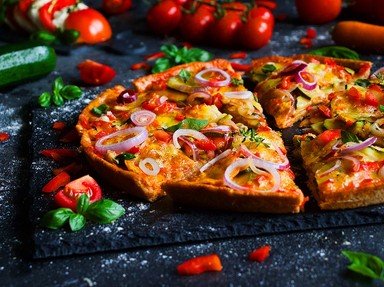Quiz Answer Key and Fun Facts
1. A wonderfully versatile ingredient, ricotta is used in Italy for both sweet and savoury dishes. In this luscious Neapolitan tart, generally eaten at Easter, fresh sheep's milk ricotta is mixed with cooked wheat berries, candied peel and orange flower water.
2. Besides the ubiquitous tiramisù and panna cotta, Italy offers many other delicious, custard-based puddings. This utterly divine dessert - found in different versions in most of central Italy - is made by layering liqueur-soaked sponge cake with pastry cream (crema pasticcera).
3. A speciality of Tuscany, these almond-studded morsels are made without added fat, and are traditionally enjoyed by dunking in dessert wine - though they will taste equally delicious with coffee or tea!
4. This striking, spiral-shaped, yeasted cake from the north-eastern region of Friuli (where it is often eaten at Christmas, Easter and other important occasions) hints at a Central/Eastern European influence, with its rich filling of nuts, raisins, candied fruits, lemon zest and Grappa (pomace brandy).
5. In many countries, the Carnival period calls for deep-fried foods, and Italy is no exception. These golden strips of dough, usually fried (but sometimes also baked), and always liberally dusted with icing sugar, are prepared and eaten in the weeks preceding Fat Tuesday (Martedì Grasso).
6. Widespread in the mountain regions of central Italy, this rustic, filling dessert is made with chestnut flour mixed with water, olive oil, raisins, pine nuts and rosemary leaves, then baked in a thin layer.
7. This rich confection is always present on the Christmas table. Made with honey, sugar, egg whites and toasted nuts (generally almonds, but also hazelnuts, pistachios or walnuts), it is usually shaped in a rectangle, and can be either hard or soft.
8. Most people will be familiar with Italian gelato - which, however, is only one of many frozen desserts available in Italy. This simple to make, but greatly refreshing (and fat-free!) treat is made with sugar syrup and fruit juice or purée, though a very popular variation involves the use of strong coffee.
9. Chocoholics will find a lot to love in Italy. These delights from north-western Italy look like king-sized chocolates hiding two layers of meringue filled with a luscious, rum-flavoured chocolate mousse.
10. This tall, butter-rich, yeasted cake from north-eastern Italy gets its name from its deep yellow colour, and is generally enjoyed with a dusting of icing sugar. Traditionally eaten at Christmastime, it is quite time-consuming to make at home, but thankfully can be bought ready-made all over the country.
Source: Author
LadyNym
This quiz was reviewed by FunTrivia editor
WesleyCrusher before going online.
Any errors found in FunTrivia content are routinely corrected through our feedback system.

